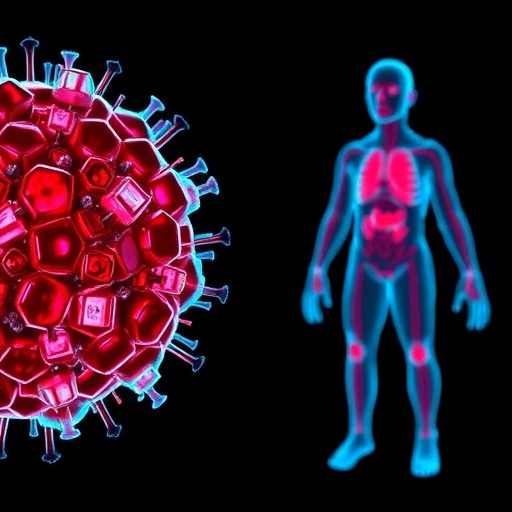A groundbreaking study led by Canadian researchers has unveiled novel insights into the intricate strategies HIV employs to hide within the human body. This research, co-led by Stephen Barr from Western University and Guido van Marle from the University of Calgary, reveals that HIV integrates itself into the DNA of infected cells following distinct, tissue-specific patterns. By embedding into unique regions of the genome across different anatomical sites such as the brain, blood, and digestive tract, the virus evades eradication and persists within the host for decades, even in individuals undergoing antiretroviral therapy.
This pioneering investigation sheds light on a long-standing mystery surrounding HIV’s stubborn resistance to cure despite decades of medical advances. Unlike prior assumptions that viral integration was random, the team discovered that the virus selectively targets certain genomic regions depending on the tissue environment. For instance, within the brain, HIV preferentially integrates into less transcriptionally active regions of the genome, effectively hiding in ‘quiet’ zones where viral gene expression is minimal. This strategic concealment helps the virus avoid immune detection and maintain latent reservoirs that can reactivate later.
Barr, a microbiology and immunology professor at Western’s Schulich School of Medicine & Dentistry, emphasized the significance of tissue-specific integration patterns. He explained, “HIV adapts its integration preferences based on the cellular context and local immune pressures in different organs, which fundamentally shapes its ability to persist over decades.” Such insights challenge earlier views and underscore the importance of tissue microenvironments in HIV infection dynamics, raising new avenues for targeted therapeutic interventions.
Leveraging rare tissue samples collected during the early years of the HIV/AIDS pandemic around 1993, when effective antiretroviral treatment was not yet available, the researchers were uniquely positioned to study the virus’s natural integration behavior across multiple organs within the same individuals. These archival specimens included the brain, blood, esophagus, stomach, small intestine, and colon, enabling a comprehensive comparative analysis of integration sites across diverse anatomical compartments.
The study utilized sophisticated genomic mapping techniques to precisely locate HIV integration hotspots within the host genome. By quantifying how frequently the virus integrated into various chromosomal regions across different tissues, the team illustrated that the patterns were anything but random. In blood cells, integration tended to occur near actively transcribed genes, a stark contrast to the brain where the virus favored genomic ‘safe zones’ with limited gene activity. This remarkable tissue-driven dichotomy suggests that local immune landscapes and chromatin accessibility profoundly influence viral integration choices.
Understanding these tissue-specific integration preferences opens transformative potential for HIV cure strategies. According to van Marle, a professor of microbiology, immunology, and infectious diseases at UCalgary’s Cumming School of Medicine, “Knowing exactly where the virus anchors itself in different tissues helps us design therapies that can directly target or silence these latent reservoirs.” This could involve novel drugs that reactivate dormant virus to purge infected cells or gene-editing approaches to excise integrated provirus selectively.
Notably, the researchers underscored the unparalleled value of historical clinical samples donated by people living with HIV during the uncertain early days of the epidemic. Their generosity, amid widespread stigma and fear, provided an extraordinary opportunity to explore viral behavior in its natural untreated state. This legacy enabled the team to identify and compare integration site preferences over anatomical sites and temporal contexts, enriching our understanding of HIV latency mechanisms.
The integration site patterns also provide clues about how the virus evades immune surveillance and antiviral responses. By entrenching itself in transcriptionally inactive genomic regions within the brain, for example, HIV effectively escapes recognition by cytotoxic T cells and other immune effectors that typically target actively infected cells. This spatial genomic seclusion likely contributes to persistent neuroinflammation and long-term neurological complications observed in some patients despite successful systemic viral suppression.
This multi-institutional effort involved collaboration between Western University, University of Calgary, the Southern Alberta HIV Clinic, and University of Alberta, symbolizing a highly coordinated approach combining expertise in virology, immunology, neuropathology, and clinical medicine. The research received funding from the Canadian Institutes of Health Research and the National Health Research and Development Program, reflecting the strategic importance of unraveling HIV persistence mechanisms.
Published in the prestigious journal Communications Medicine, the findings mark a transformative step toward decoding the viral reservoirs that thwart eradication efforts. By mapping HIV integration landscapes across anatomical sites from historical cases, researchers have illuminated new biological principles that govern viral latency and persistence. These insights are critical in guiding next-generation therapeutic technologies aiming not just to control but to cure HIV infection worldwide.
The future implications of this research extend beyond HIV itself. Understanding tissue-specific viral integration and latency mechanisms can inform strategies against other persistent viral infections and deepen fundamental insights into virus-host genome interactions. Ultimately, this study propels the scientific community closer to achieving the long-sought goal of an HIV cure by revealing vulnerabilities previously concealed within the viral DNA’s genomic sanctuaries.
Subject of Research: People
Article Title: Early pandemic HIV-1 integration site preferences differ across anatomical sites
News Publication Date: 6-Oct-2025
Web References: http://dx.doi.org/10.1038/s43856-025-01146-5
Image Credits: Frank Neufeld
Keywords: Diseases and disorders, Infectious diseases




